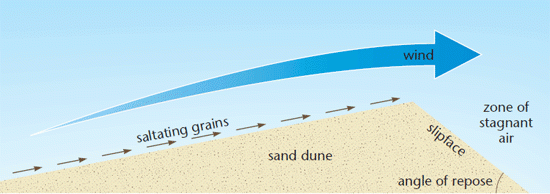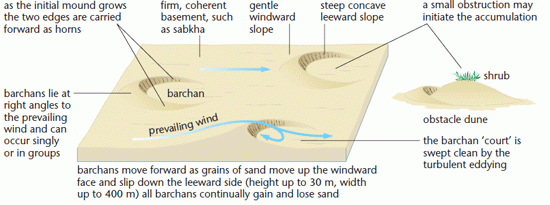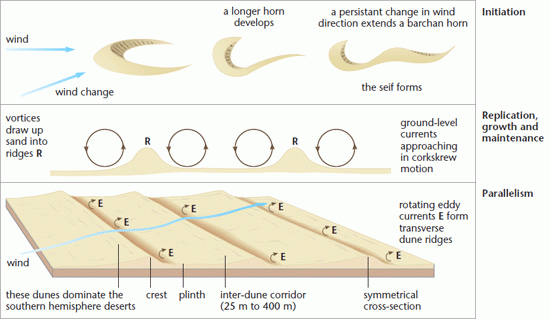Features produced by Wind Deposition
Wind-deposited materials occur as sand sheets, ripples and dunes.
Sand sheets
These are flat areas of sand with sand grains that are too large to saltate. 45% of depositional surfaces are of this type, e.g. Selima in South Egypt.
Dunes
The wind eventually blows sand into a network of troughs, crests and ripples that are perpendicular to the wind direction. They are the consequence of saltation (see below).

These dunes move fast! Between 1954 barchans in China’s Ningxia Province were moving at more than 100 m per year!
Accumulations of sand build into mounds and ridges, they become a dune when the slip face is about 30 cm high. Dunes grow as sand particles move up the gentle upwind slope by saltation and creep. They fall onto the slipface inducing movement.
KEY POINT - Sandstorms - Sandstorms are a seasonal hazard in North East Africa, and are called Khamasin (fifty) for the number of days on which they occur. They strike around April with the onset of warm conditions. Hot rising air lifts dust up to 4500 metres above the desert. Returning as brown rain in winds of up to 110 kph it closes airports and causes many accidents. Annually at this time up to 20 people die due to the sandstorms. When the sand moves west it can destroy coral reefs in the Caribbean and has been linked to hurricane formation.
Five basic dune shapes have been recognised: crescentic, linear, star, domes and parabolic. Ralph Bagnold, an engineer, working in Egypt, prior to the Second World War recognised the main dune types, the crescent or barchan dune and the linear or seif dune systems (seif is Arabic for sword).
Outside of the USA, sand dunes make up 25% of arid landforms.
Barchan Dunes
(Barchan means ‘active dune’. These dunes move!) Found in Northern Chad,Taklamakan Desert in China, Namib Desert in Namibia.

Star dunes are pyramidal in shape. They are the tallest dune. Parabolic dunes have ‘arms’ pointing upwind.
Linear dunes (seif, transverse dunes or draa)
As to formation these dunes are either:
- the result of obstacles getting in the way
- an erosional phenomenon
- as products of a vegetated landscape or,
- as products of complex wind regimes, secondary wind flow patterns (and large amounts of sand)

